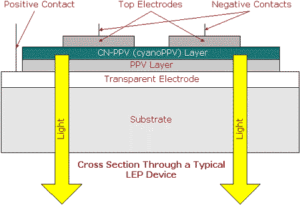The Universal Display Corporation’s TOLED is based on small-molecule organic light emitting materials. Another of the high-profile OLED development companies, Cambridge Display Technology (CDT), is putting its faith in large-molecule, or polymer, organic light emitting materials.
The company’s light-emitting polymer (LEP) technology was born in Cambridge University’s Cavendish Laboratory in 1989, where three researchers (Bradley, Burroughes and Friend) were involved in the development of cheap, flexible, disposable electronics. They were investigating the properties of conjugated polymers, a group of plastics which conduct electricity almost as well as copper, thanks to their structure of alternating bonds and shared electrons. One day, a piece of plastic, poly(p-phenylene vinylene) or PPV, through which a current was being passed began to pump out pale yellow-green light. Within a short time, thanks to funding from rock group Genesis, CDT was formed.
The way light is produced in an LEP is the same as in other OLED’s: electrons and holes, flowing in opposite directions between two electrodes, meet. The electron “drops into” the hole and releases its extra energy as light. The greater the difference in energy between the hole and the electron; the further from red and the closer to blue the light given off. Not surprisingly, early displays produced by CDT were closer to the red end of the spectrum than the blue and it wasn’t until November 1999 that the company announced the development of a blue-emitting polymer material with the assistance of Dow Chemical. This meant that the company could, in theory, produce a full-colour display using red, green and blue emitting polymers.
The method the company has chosen to develop a full-colour display is by applying the three relevant polymers to substrates using ink-jet deposition. Working with ink-jet veterans Seiko Epson, CDT applies drops of the treacle-like liquids as small as 30 microns across onto a patterned electrode array. Like UDC, CDT is some years away from producing a commercial product but with a technology that it believes has a 40% price advantage over LCDs, and which like UDC’s FOLED can be used with flexible substrates, the company is sure that it has a winning formula.
Update: Polymer OLEDs are just coming out of the laboratory and into production applications at the time of writing (July 2006). CDT has done a lot of work on inkjet patterning, with other deposition methods such as direct lithography, laser deposition and shadow mask deposition all under development. Deep blue with efficiency and with a long life time is still a struggle, but lifetimes of OLEDs are getting good enough for applications such as mobile phones and MP3 player displays. OLED developers still believe that they can offer a significant cost saving compared to LCD because of the simpler device structure.

